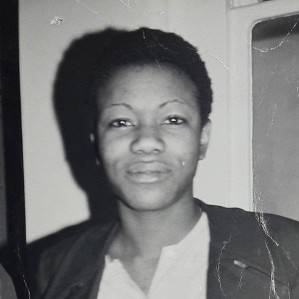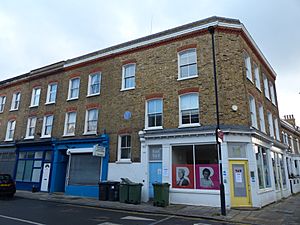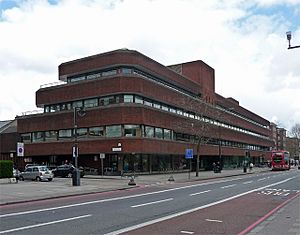Olive Morris facts for kids
Quick facts for kids
Olive Morris
|
|
|---|---|
 |
|
| Born | 26 June 1952 St Catherine, Jamaica
|
| Died | 12 July 1979 (aged 27) Lambeth, London, UK
|
| Education | London College of Printing Victoria University of Manchester |
| Occupation | Community leader and activist |
Olive Elaine Morris (born June 26, 1952 – died July 12, 1979) was an important community leader and activist. She was born in Jamaica and lived in Britain. In the 1970s, she fought for the rights of women, Black people, and people who needed housing.
When she was 17, police officers hurt her in Brixton, South London. After this, she joined the British Black Panthers. She became a strong supporter of Marxist–Leninist communism and radical feminism. Olive helped people find homes by taking over empty buildings in Brixton. One of these buildings became Sabarr Books, and later the 121 Centre. Another was used by the Race Today group.
Olive was a key organizer in the Black Women's Movement in the UK. She helped start the Brixton Black Women's Group and the Organization of Women of African and Asian Descent in London. She continued her activism while studying at the Victoria University of Manchester. She was part of the Manchester Black Women's Co-operative and even traveled to China.
After finishing university, Olive returned to Brixton. She worked at the Brixton Community Law Centre. Sadly, she became ill and was diagnosed with non-Hodgkin lymphoma, a type of cancer. She died at just 27 years old. Many groups remember her work. Lambeth Council named a building after her. The activist group Remembering Olive Collective (ROC) also honors her. Friends remember her as brave and dedicated to fighting unfairness. She was even featured on the B£1 note of the Brixton Pound.
Contents
Early Life
Olive Morris was born on June 26, 1952, in Harewood, St Catherine, Jamaica. Her parents were Vincent Nathaniel Morris and Doris Lowena. She had five brothers and sisters. When her parents moved to England, Olive lived with her grandmother for a while. At age nine, she joined her parents in South London. Her father worked as a forklift driver, and her mother worked in factories.
Olive went to several schools in London, including Heathbrook Primary School. She left school without formal qualifications. Later, she studied for her O-Levels and A-Levels. She also took a class at the London College of Printing, which is now called the London College of Communication.
Adult Life and Activism
In the late 1960s and 1970s, many Black British activists discussed important ideas. These included Black nationalism, classism (unfairness based on social class), and imperialism (when one country controls another). They talked about these issues in Africa, Asia, the Caribbean, and the United Kingdom. Their main goals were to find their identity and help their own communities. They also wanted to support others facing similar challenges.
Even after the Race Relations Act 1965 was passed, Black people and other minority groups still faced racism. It was hard for them to find housing and jobs because of unfair rules. Black communities also faced pressure from the police and racist groups like the National Front. To fight these problems, Black Britons used ideas from anti-colonial movements. They also adopted cultural expressions inspired by African liberation movements.
Olive Morris joined this movement because it helped her connect with her Caribbean roots. It also gave her a way to fight against problems in her community. She was just over five feet tall but became known as a very strong activist. Other activists described her as fearless and dedicated. She refused to let unfairness happen. Olive had a unique style. She often wore jeans and t-shirts. She also wore her hair in a short Afro style. Her personal choices challenged ideas about what it meant to be British or Caribbean.
British Black Panthers
Olive decided to fight against police harassment. She joined the youth section of the British Black Panthers in the early 1970s. This group was not directly linked to the Black Panther Movement in the United States. However, both groups focused on improving local communities. The British Panthers promoted Black Power and wanted to unite people of African descent.
In the early 1970s, many Black activists faced unfair court cases. Olive was arrested during the trial of the Oval Four. This happened after a struggle with police officers outside the Old Bailey courthouse. She was accused of hurting an officer. During her trial in October 1972, the police officers gave different stories. The jury found Olive and the other people not guilty.
After the British Black Panthers ended, Olive Morris helped start the Brixton Black Women's Group in 1973. She founded it with her friends Liz Obi and Beverley Bryan. This group provided a place for Asian and Black women to talk about politics and culture. They felt that some issues discussed by white feminist groups were not as important to Black women. For example, Black women were more concerned about getting paid fairly for their cleaning jobs.
The group was organized so that everyone had an equal say. They published a newsletter called Speak Out. They also produced a book called The Heart of the Race: Black Women's Lives in Britain. This book was published in 1985 and was dedicated to Olive Morris.
Squatting in Brixton
Olive Morris started squatting in empty buildings in Brixton because she needed a place to live. She soon realized that taking over these buildings could also help with political projects. Squatting allowed the Brixton Black Women's Group to be independent.
In 1973, Olive and Liz Obi squatted at 121 Railton Road. When workers tried to remove their belongings, Olive and Liz quickly moved back in. They then made a deal with the property agent. Olive told a newspaper that "the prices for flats and bedsits are too high for me." A group called the Advisory Service for Squatters even used a photo of Olive climbing a wall on the cover of their handbook.
The building at 121 Railton Road became a center for political activism. It hosted groups like Black People against State Harassment. The Brixton Black Women's Group also met there. A bookshop called Sabarr Bookshop was set up by local Black men and women, including Olive. Through the bookshop, activists worked with schools to provide books about Black history. This helped schools create a more diverse curriculum. Olive and Liz later moved to another squat at 65 Railton Road.
The 121 squat later became a self-managed social centre known as the 121 Centre. It was a place for community activities until 1999. Olive believed that housing was a human right. She saw squatting as a way to directly help people find shelter. She encouraged others to squat too. Olive also worked with the Race Today group. She helped them find a base in the Brixton squats. Their offices were at 165–167 Railton Road. They produced their magazine there and held discussions.
Manchester
Olive Morris studied economics and social science at the Victoria University of Manchester from 1975 to 1978. She quickly joined local political groups in Moss Side. She helped start the Black Women's Mutual Aid Group. She also met local activists like Kath Locke and Elouise Edwards. Olive became involved with the Manchester Black Women's Co-operative (MBWC). Members remembered her energy and passion.
She also campaigned against the university's plans to increase tuition fees for students from other countries. After Olive's death, the MBWC became the Abasindi Women's Co-operative. This group organized educational, cultural, and political activities without public funding.
Olive helped create a supplementary school after working with local Black parents. They wanted better education for their children. She also helped set up a Black bookshop. Olive had a global view of activism. She traveled to Italy and Northern Ireland. In 1977, she visited China and wrote about her trip for the Brixton Black Women's Group newsletter. Her article discussed anti-imperialist ideas and community organizing in China.
Return to Brixton
After graduating in 1978, Olive returned to Brixton. She worked at the Brixton Community Law Centre. With her partner Mike McColgan, she wrote a pamphlet. It questioned whether the Anti-Nazi League was right to fight fascism while ignoring racism within institutions.
With educators Beverley Bryan and Stella Dadzie, Olive helped create the Organization of Women of African and Asian Descent (OWAAD) in London. OWAAD held its first conference at the Abeng Centre in Brixton. Olive had helped to found this center. Beverley Bryan later remembered Olive as a "strong personality."
At the conference, 300 women from African, Asian, and Caribbean backgrounds gathered. They came from cities like Birmingham, London, and Manchester. They discussed important issues like housing, jobs, health, and education. OWAAD aimed to be a group that connected different struggles. It wanted to empower women and fight against racism, sexism, and other forms of unfairness. OWAAD was one of the first organizations for Black women in the United Kingdom. Olive edited FOWAD!, the group's newsletter, which continued after her death.
Death
In 1978, Olive Morris felt ill while on a cycling trip in Spain. When she returned to London, she went to King's College Hospital. She was first given tablets for flatulence. Later, in September, she was diagnosed with non-Hodgkin lymphoma, a type of cancer. The cancer treatment did not work. Olive died on July 12, 1979, at St Thomas' Hospital in Lambeth. She was only 27 years old. Her grave is at Streatham Vale Cemetery.
Recognition and Legacy
Olive Morris played a very important role in creating a Black Power movement for women in the UK. The Brixton Black Women's Group published a tribute to her. They praised her "total dedication to the struggles for liberation, democracy and socialism." The poet Linton Kwesi Johnson also wrote a poem in her memory.
In 1986, Lambeth Council named a new building after Olive Morris. This happened after a campaign by the Brixton Black Women's Group. The building was at 18 Brixton Hill. The local housing benefit office was located there. Olive had protested outside that office for better housing rights. The building was taken down in 2020. A playground in Myatt's Fields was also named after Olive Morris.
In 2000, Liz Obi organized an exhibition about Olive Morris at Brixton Library. In 2007, a blog called "Remember Olive Morris" was started to honor her. The Remembering Olive Collective (ROC) was launched the next year. This group collects information about Olive's life. They also connect her experiences to the history of Black Brixton. In 2010, they published a pamphlet called Do You Remember Olive Morris? and gave it to local schools.
In 2011, ROC started the Olive Morris Memorial Awards. These awards offer financial help to women of African or Asian descent aged 16 to 27. In 2019, ROC was re-launched as ROC 2.0. This was because the council building named after Olive was going to be taken down. The group wanted to make sure she would still be remembered.
The materials collected by the Remembering Olive Collective are now part of the Olive Morris Collection. These are kept at the Lambeth Archives. The archives will move to a new Olive Morris House in the future.
Olive Morris is shown on the B£1 note of the Brixton Pound, which is a local currency. In 2017, a mural called "SAY IT LOUD" was painted in Brixton. It pays tribute to Olive Morris. In 2018, The Voice newspaper listed Olive Morris as one of eight Black women who helped develop Britain. The Evening Standard also listed her as one of 14 "Inspirational Black British Women Throughout History." On June 26, 2020, Google honored Olive Morris with a Google Doodle in the UK. This was to mark what would have been her 68th birthday.
See also
 In Spanish: Olive Morris para niños
In Spanish: Olive Morris para niños



